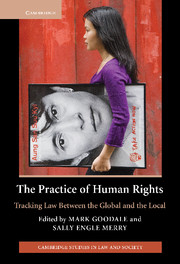Book contents
- Frontmatter
- Contents
- Contributors
- Acknowledgments
- Introduction Locating rights, envisioning law between the global and the local
- PART ONE STATES OF VIOLENCE
- Introduction
- 1 Human rights as culprit, human rights as victim: rights and security in the state of exception
- 2 “Secularism is a human right!”: double-binds of Buddhism, democracy, and identity in Nepal
- PART TWO REGISTERS OF POWER
- PART THREE CONDITIONS OF VULNERABILITY
- PART FOUR ENCOUNTERING AMBIVALENCE
- Conclusion Tyrannosaurus lex: the anthropology of human rights and transnational law
- Index
- References
Introduction
States of Violence
Published online by Cambridge University Press: 29 March 2011
- Frontmatter
- Contents
- Contributors
- Acknowledgments
- Introduction Locating rights, envisioning law between the global and the local
- PART ONE STATES OF VIOLENCE
- Introduction
- 1 Human rights as culprit, human rights as victim: rights and security in the state of exception
- 2 “Secularism is a human right!”: double-binds of Buddhism, democracy, and identity in Nepal
- PART TWO REGISTERS OF POWER
- PART THREE CONDITIONS OF VULNERABILITY
- PART FOUR ENCOUNTERING AMBIVALENCE
- Conclusion Tyrannosaurus lex: the anthropology of human rights and transnational law
- Index
- References
Summary
How does the human rights framework deal with violence? Asking this question from the perspective of human rights practice rather than human rights principles means focusing on how principles are translated in everyday situations. The argument of the book is that understanding the practice of human rights requires attention to the people who translate documents into social situations and situations into human rights violations. The people in the middle are activists, movement leaders, academics, and those who speak for victims, including some victims themselves. These are the people who construct human rights cases, transform them in ways that will increase their appeal, and try to mobilize pressure behind the principles. A key dimension of this process is defining and naming problems as human rights violations.
As they define problems as human rights issues and generate support for them, these intermediaries confront the question of what constitutes violence. Violence is a fundamental aspect of many human rights violations, yet only some kinds of violence are considered human rights offenses. Physical injury and death are often viewed as violations, but other forms of violence are not, such as economic violence, environmental degradation, or the violence of development. Moreover, on closer examination even the violence of injury and death is very ambiguous. The meaning of injury or death depends on cultural assumptions about how and why it occurred, whether it was justified, whether it was the product of malice or accident, and whether it served the good of the country.
- Type
- Chapter
- Information
- The Practice of Human RightsTracking Law between the Global and the Local, pp. 41 - 48Publisher: Cambridge University PressPrint publication year: 2007
References
- 12
- Cited by



